The Evolving Story of Kim Bennett
“When he first heard the Beatles’ tapes, Kim told me he said: ‘Now who hasn’t got a group in EMI? Let me see, Norrie’s got the Shadows’ and he ran through all the recording managers until he came to George Martin.”
Beatles Book Monthly – Issue 70 (May 1969)
Pt. 1: Before Lewisohn
0. Mark Lewisohn’s Star Witness
2. The Evolving Story of Kim Bennett, Pt. 1: Before Lewisohn >You Are Here<
3. The Classic™ Contract Story, and Why Lewisohn Distrusts It
4. The Evolving Story of Kim Bennett, Pt. 2: Tune In
5. Lewisohn’s Other Sources
6. Lewisohn’s Portrayal of Kim Bennett & George Martin

After two posts and as many months of build-up, it’s finally time to look at Kim Bennett’s presence in Beatles history before Mark Lewisohn’s Tune In. As a refresher, Kim Bennett was a music plugger involved in a brief chapter of the Beatles’ story, who Lewisohn draws on as a crucial witness to ~debunk the myth~ of how the Beatles’ first landed their recording contract with Parlophone. I’ve previously shown an example of Kim Bennett’s presence in Beatledom here, in an issue of Beatles Book Monthly, just a few pages before the name of a young Mark Lewisohn. I’ve also discussed some of the ways Lewisohn slants a story when he’s set on overturning a classic narrative – you can find that here.
Section 1: Mark Lewisohn on Kim Bennett
Part of the appeal of Mark Lewisohn’s Beatles-signing scoop is Kim Bennett’s oft-stated absence from the Beatles narrative. Lewisohn found and memorialized a man who had been marginalized from the Beatles’ story, a hero integral to their success who was erased from history due to his inconvenience to the legacy of a certain acclaimed producer. Not only has Lewisohn turned a classic narrative upside down, he’s righted the wrong done to Kim Bennett by the powers that be–or so he would have us believe. The importance of Bennett’s testimony and his exclusivity to Tune In is a crucial element of Lewisohn’s myth-building around himself and his work. Let’s take a look at a few examples:
In a 2014 interview with Dierdre Kelly, Lewisohn calls his revised version of the Beatles’ recording contract “probably one of the biggest things in the book.” As for how he came to that version of events, Lewisohn says, “It all fell into place when I met a man called Kim Bennett…without whose incredibly tenacious efforts—and he was never named in any book—we would never have heard of the Beatles. He literally was the story’s hero and he tells us a very different story.” [Emphasis mine]
From Allan Kozinn’s 2013 interview with Lewisohn, we get the following exchange:
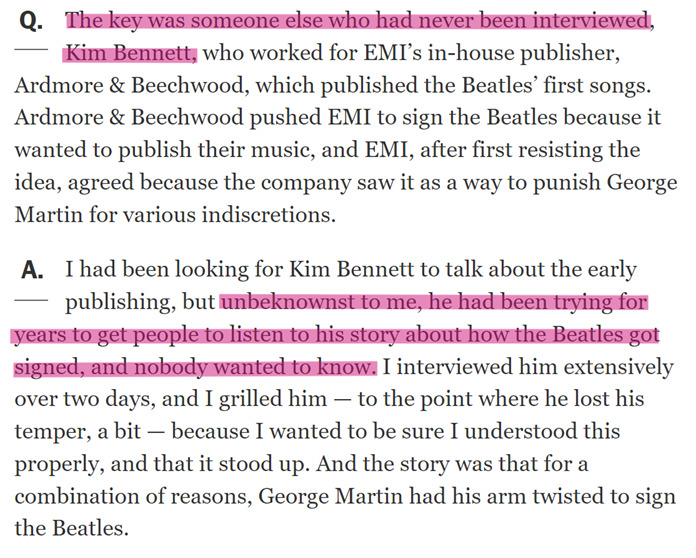
Kozinn describes Bennett as “someone who had never been interviewed,” and Lewisohn not only doesn’t correct him, he furthers that idea by saying Bennett “had been trying for years to get people to listen to his story…and nobody wanted to know.”
As a final example, we’ll return to the episode of Nothing Is Real (season 7, ep. 7) that I excerpted in my first post on Bennett.
Nothing Is Real – Season 7 Episode 7 – Mark Lewisohn excerpt
A partial transcript [emphasis mine]:
“I approached him, and he was so happy that I got in touch with him because he knew the true story of how the Beatles came to be signed to EMI and he knew that it was his efforts that had made the difference, and without him, it wouldn’t have happened. The Beatles possibly may never have happened without Kim Bennett, and he’d been trying to tell people for years, and people didn’t want to know.”
“He was a very frustrated man because no one had ever paid him the attention that he felt was his due.”
“…and if I hadn’t of got to him when we did, we wouldn’t know him, and we would always have that bizarre gap of how they got signed by someone who never met them.”
Again and again, Lewisohn tells us that Kim Bennett had been trying desperately for years to gain recognition for his action, and everyone ignored him–everyone but Mark Lewisohn. This is decidedly untrue. He has been mentioned in multiple Beatles publications by major names in Beatles history, which you can find in Section 3.
But first!
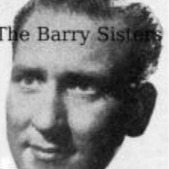
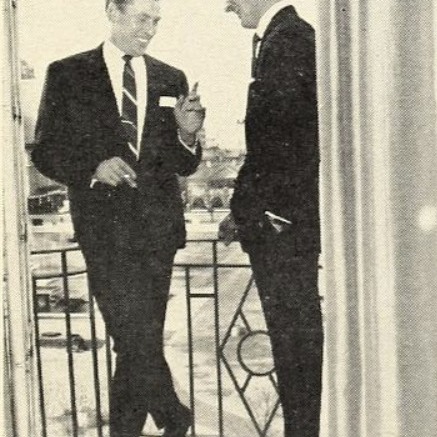
Section 2: Biographical & Background Info
I’ve dug up some biographical information on the enigmatic Kim Bennett, and I wanted to share it here along with a little context about music publishing to make the accounts shared in the next section make mroe sense. If you’re confident in your early-1960s music industry knowledge and know who Kim Bennett and Sid Colman are, you can skip straight to Section 3.
I’ve cited Lewisohn a few times in this section when other sources weren’t available. Every time I cite him, I put a quarter in the “Risky Citations” jar – once I’ve filled it a few hundred times, I’ll take it to CoinStar and use the money to buy a copy of Fifty Years Adrift.
The Parlophone Contract Story is a story with many bit parts, most of whom won’t appear until my next post–there will even be a figure! I’ll assume you know the Beatles, Brian Epstein, and George Martin, the man who would become the Beatles’ main producer. In the parlance of the times, George Martin was the A&R man (artistes and repertoire) of EMI’s Parlophone label. As the A&R man at Parlophone, George M. has the head of the label, with duties including scouting artists, matching his stable of artists with songs, and overseeing the recording process.
Alongside record labels like Parlophone, Columbia, and HMV, EMI had other companies under its corporate umbrella. One of these companies was the music publisher, Ardmore & Beechwood (A&B).
Music publishers manage song copyrights; they make money by marketing and disseminating those songs. In the early 20th century, the big moneymaker for music publishers was sheet music sales. By the 1950s and 60s a sea change was in progress as record sales grew and eventually eclipsed the sale of sheet music. Just as the medium through which songs were sold changed, so did the way in which music publishers sold those songs: originally, song pluggers from publishing companies would pitch their songs to orchestras, brass bands, and dance halls, seeking out groups who performed live music, so that their audiences would go out and buy sheet music of the songs they’d heard (Southall & Perry 2006, p.ix-xii). With the rise of records, song pluggers would pitch their songs directly to A&R men; they would visit the A&R men in their office and sing the songs they had on offer, accompanying themselves on the piano while they did (Martin & Hornsby 1979, p.48). They could then market those records to sell their songs. If a song was recorded by multiple artists, as was often the case, the song publisher benefited regardless of which version of a song played. This set their interests slightly apart from record producers, who only benefited if their version of a song sold.
Let’s illustrate with a Lennon-McCartney original: the music publisher for Lennon-McCartney’s music, Northern Songs, would profit from both the Rolling Stones version of ‘I Wanna Be Your Man’ and the Beatles version, but the record companies would only benefit from the version they released – the Stones version meant money in Decca’s pocket, while the Beatles version benefited EMI.
(I’m sure their are some additional business/contract complexities that come into play, but I believe the general principle is correct)
EMI Music Publishing would one day be a Big Fucking Deal, but when the Beatles joined in 1962, it didn’t exist yet. Publishing was a minor interest for the company, and they had only a small publishing presence in the form of A&B, which opened in 1958 (Martland 1997, p.262). A&B was set up to handle the publishing interests of two American companies, Ardmore Music Corp. and Beechwood Music Corp., both of which were owned by Capitol Records (Cash Box 1958 Jul 26, p.34). Capitol Records had been purchased by EMI in 1955 (Southall 2009, p.25), and A&B was set up a few years later to handle their catalogue in the U.K., while also providing and option to publish through EMI for any interested songwriters. This was done at the behest of EMI Chairman Sir Joseph Lockwood (Southall 2006, p.9-10).
From its genesis, veteran music publisher Sid Colman (1905-65) served as general manager of Ardmore & Beechwood (Cash Box 1958 Jul 26, p.34). He would serve in this role until his untimely death in April 1965 (Cash Box 1965 Apr 24, p.47). You will encounter multiple spellings of his name, but Lewisohn assures us that Sid Colman (rather than Syd Coleman) is correct (2013, p.856). Kim Bennett served as his assistant and music plugger.
Born Thomas Whippey (1931-2004) (Lewisohn 2013), he became a Decca recording artist in 1954 under the name Kim Bennett. He recorded six singles, none of which charted. I haven’t found any of his work online, but for an idea of the type of music he released, here are other versions of two songs he put out: ‘Softly, Softly’ by Ruby Murray and ‘The Kentuckian Song’ by Eddy Arnold. He maintained a day job as an office worker until 1955, then briefly worked as a musician full time. He worked a season at Butlin’s (not the same location as Ringo), played some clubs, and toured with the Ambrose orchestra, but his career as a singer had petered out by late 1956. As Don Wicks puts it “[h]e was a victim of the growing rock and roll industry no longer interested in a soft pleasant vocal style.” (Wicks 1996 pt.1)
He resumed work at a toy warehouse, (Wicks 1996 pt.1) but later took a job in music publishing with B. Feldman & Co. Ltd. (Cash Box 1967 Jul 22 p.65). He began work with Ardmore & Beechwood no sooner than August 1958. He was still with Ardmore & Beechwood as of June 1965 (Cash Box 1965 Jun 5 p.55). By July 1967, he had moved to South Africa, where he ran a newly launched publishing company, Francis Day (S.A.) (Pty), which was established to manage copyrights of B. Feldman & Co. Ltd., Francis Day & Hunter, and Robbins (Cash Box 1967 Jul 22 p.65).
According to Lewisohn, Bennett spent his later years in Shropshire in “quite humble circumstances (Nothing Is Real, Season 7 Ep. 7, 29:30). He was interviewed by Lewisohn on July 27-28, 2003 (Lewisohn 2013 p.869). He died in 2004.
While biographical information on Bennett between 1967 and 2003 is slim (perhaps nonexistent), his role in the Beatles story received several mentions in print in those intervening decades.
Section 3: Kim Bennett in Beatles History
As I highlighted in my first post in this series, Kim Bennett was quoted in Beatles Book Monthly Issue 70, but that isn’t his earliest appearance in the Beatles lore – he first appears in an earlier issue of BBM, issue 13, published in August 1964, p.22-3. He’s mentioned by BBC DJ Ted King in relation to his work plugging ‘Love Me Do’.
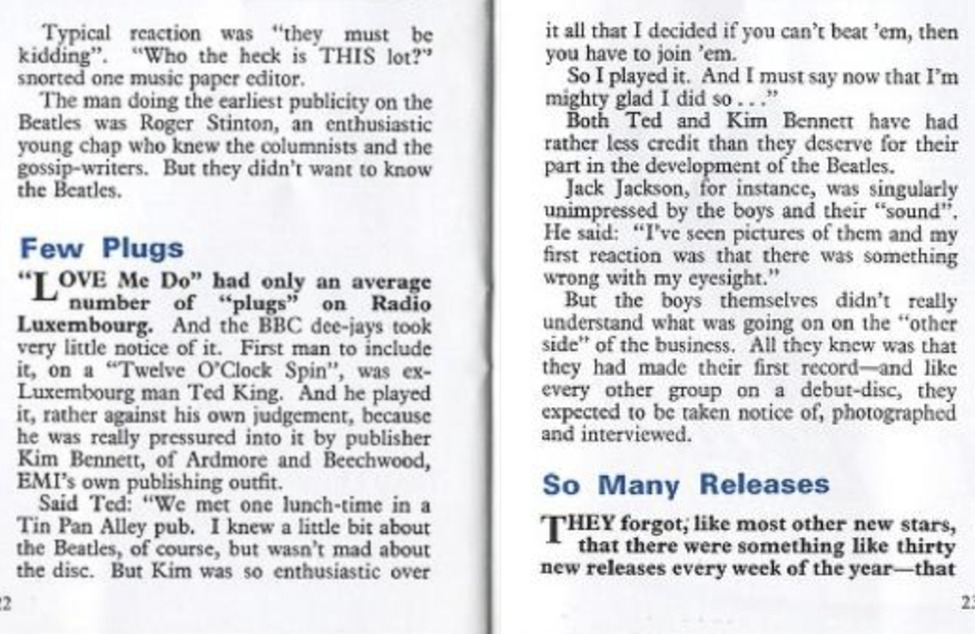
To summarize: Kim Bennett went to lunch with Ted King and pitched “Love Me Do” to him. King wasn’t fond of the record, but Bennett’s enthusiasm convinced King to play it on “Twelve O’Clock Spin.”
Our next Bennett sighting (and the first to use Bennett as a source) is the aforementioned BBM Issue 70, p.8, published May 1969.
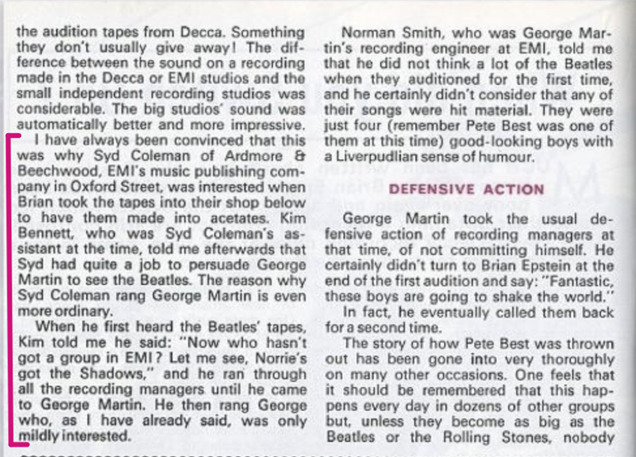
This is part of a piece titled “When did you Switch On?” whose author is unattributed. Whoever they are spoke to Kim Bennett directly. Here’s what we can gather from this piece:
- Kim Bennett was Sid Colman’s assistant
- Colman “had quite a job to persuade George Martin to see the Beatles”
- Bennett, presumably, was in the room when Colman “first heard the Beatles’ tapes”, since Bennett is able to relate what Sid Colman said on the matter
- Colman decided to call Martin because he did not have a similar-sounding pop group, while the other EMI A&R men did
Bennett next crops up in several of Bill Harry’s books, starting in 1982. Bill Harry is the founder of Mersey Beat and was an art school chum of John and Stu’s; he’s written a number of reference books about the Beatles, including The Beatles Encyclopedia, The John Lennon Encyclopedia, and The Book of Beatle Lists, among many others. Four of his books mention Bennett. The information in these books seems to be pulled from the two BBM articles highlighted above – with the possible exception of the last one. The books where Bennett is mentioned include:
The Beatles Who’s Who (1982): An encyclopedia of Beatle people. Bennett does not get his own entry, but he is mentioned in the entry on Sid Colman (p.84). Bennett is said to be Colman’s assistant, and his involvement in “Love Me Do” promotions is noted without detail.
The Ultimate Beatles Encyclopedia (1992): Bennett now gets his own entry (p.84-5). Again, this appears to draw from the Beatles Book articles. More detail is included here than in The Beatles Who’s Who. Bennett is mentioned again in Sid Colman’s entry (p.168). There’s a reference to Colman and Bennett liking the demos for “Love of the Loved” and “Hello Little Girl”, which is not mentioned in BBM above. However, these songs were referenced in relation to Sid Colman in The Beatles Who’s Who, so I think Bennett is just lumped in with Colman here.
Also in the Colman entry, Harry points out two conflicting accounts of the promotion of “Love Me Do.” George Martin wrote in his memoir that Ardmore & Beechwood did “virtually nothing” to promote the song, but Ted King, in BBM Issue 13, said it was Kim Bennett who got him to play the song on “Twelve O’Clock Spin.” This apparent contradiction will be discussed in detail when we deal with Tune In’s version of events, but for now, I’ll say this: it can be true that Kim Bennett did his best to promote ‘Love Me Do’ and acheived limited success while still falling short of the expectations of George Martin (and, crucially, Brian Epstein).
The Encyclopedia of Beatles People (1997): Bennett has a brief entry (p.45) and is mentioned in Sid Colman’s entry (p.92-93.) The Sid Colman entry includes this quote from Sir Joseph Lockwood about the Beatles’ publishing rights “I don’t blame Sid Coleman [sic], because he published the first two songs without a contract. He wasn’t getting any support from either the record producers or the solicitors.” This quote appears in Ray Coleman’s The Man Who Made The Beatles (1989), seemingly from an interview conducted by Coleman while researching that book.
The Ultimate Beatles Encyclopedia (Revised & Updated, 2001): The entry for Kim Bennett includes the entirety of the entry in the 1992 version with an additional two paragraphs (p.135-6). These paragraphs are emotionally charged and add information not available in the two articles from BBM. After detailing Bennett’s involvement in ‘Love Me Do’ promo, Bill Harry writes,
“It’s ironic that the two people who were so enthusiastic about the Beatles and helped to get them with EMI in the first place were to have George Martin shut the door in their face by suggesting to Brian Epstein that he see Dick James about being their publisher. For one thing, it was Coleman [sic] who, after talking to Brian realized that the only A&R man at EMI who hadn’t rejected the Beatles was George Martin. Apparently, Coleman had a hard job persuading Martin to see Epstein. Even then, Martin wasn’t initially impressed by their sound. He only agreed to a test session at EMI’s No. 3 studio four weeks later, then another three months elapsed before the release of their first single. EMI and Martin weren’t even confident enough to give the Beatles a plug rating. Artists such as Cliff Richard received an ‘A’ plug on EMI’s Radio Luxembourg shows. The lowest was ‘B2’. The Beatles weren’t even given this low plug, EMI gave ‘Love Me Do’ a nil rating. “So Bennett had a hard job pushing the record without EMI using their clout. As a result, Epstein refused Ardmore & Beechwood the future Beatles publishing. Had he done so, the Beatles might have retained the rights to their own songs, and Coleman might have received some acknowledgment for having placed the Beatles into his hands in the first place.”
It’s hard to say whether or not additional information from Kim Bennett made it into this article. Much of this could be pulled from other sources and presented through a negative lens stemming from Dick James’ involvement in the Northern Songs debacle. There are, however, two elements here that are consistent with Bennett’s later accounts that might suggest that he spoke with Bill Harry: (1) the phrasing that George Martin “shut the door” in the face of A&B, rather than Brian Epstein actively seeking out a different publisher and going to George for advice, and (2) the blame placed on George Martin for the Beatles low plug rating. Both new elements, and both inconsistent with certain other versions of events.
In Philip Norman’s revised Shout! (2003), there is unambiguous evidence of Kim Bennett’s participation.
In the original 1981 release, Sid Colman and A&B are mentioned, but not Bennett; in the revised edition, not only is Kim Bennett present, but the information surrounding him is clearly more than the familiar, regurgitated tale found in Beatles Book Monthly.
Norman doesn’t give citations, so I can’t say conclusively how he got this new information. There may be an interview with Kim Bennett published somewhere that I haven’t come across, though I’m inclined to believe either Norman or one of his research assistants spoke to Kim Bennett directly. The phrase “According to Bennett” appears a few times in Shout! (2003), which reads as if the information is coming directly from the horse’s mouth, so to speak.
Since the revised edition was published in the same year as Lewisohn’s interview with Kim Bennett, I considered that Lewisohn might have shared his information with Norman, and Norman may have rushed an edit. I looked for the exact publication date for the revised edition of Shout!—it was weirdly hard to find—and that put to bed any ideas of Norman cribbing off of Lewisohn’s notes: Pan Macmillan Australia gives the release date as January 9, 2003, several months before Lewisohn interviewed Bennett.
The Contract Story, as presented in the revised Shout! starts in the usual way: Brian gets an acetate made from the Beatles’ demo tape, the technician likes it and puts Brian in touch with Sid Colman, who works for A&B upstairs. Colman is interested in publishing the original Lennon-McCartney numbers. Then Kim Bennett enters the picture (Norman 2003, p.164-5):

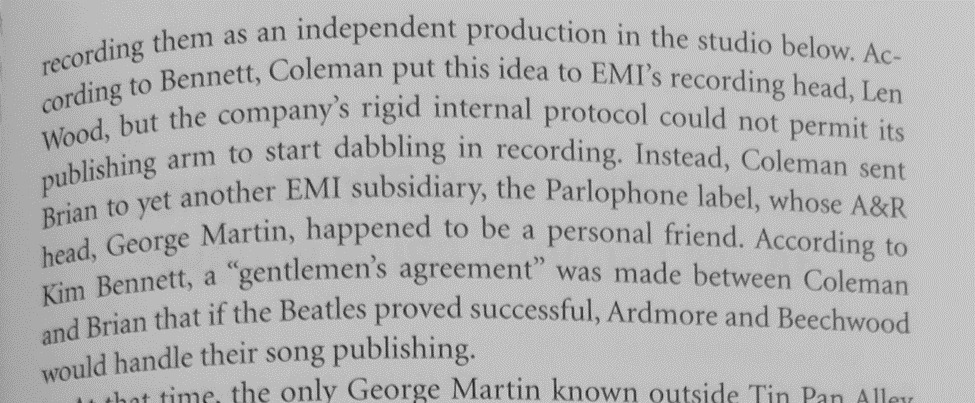
Bennett likes the disc, too, and suggests they record the Beatles independently in the for-hire studio below their Oxford Street office. Colman takes Bennett’s idea to Len Wood, managing director at EMI, but it goes against protocol, and Wood won’t allow it. Only then does Colman put Brian in touch with George Martin. Colman and Brian have a “gentlemen’s agreement” that A&B will get the Lennon-McCartney publishing rights if they get a contract with George M.
It’s a short passage, but there are already a few problems here. First, the timeline doesn’t make sense. Most early accounts have Brian’s meeting with George M. occurring the day after Sid Colman hears the tapes (see A Cellarful of Noise, The Beatles (1968), and All You Need Is Ears). The largest gap is given by Lewisohn’s Chronicle (p.53-55), in which Epstein is said to have met Colman “around February 8” (a Thursday), with the Epstein-Martin meeting occurring on Tuesday, February 13. The Epstein-Martin meeting date seems to be pulled from George Martin’s date book (he has a meeting with a “Bernard Epstein” on that date), but I’m unsure what brought Lewisohn to the February 8 conclusion. Based on other information in the Chronicle, my best guess is either a meeting between Colman and Martin on February 9th, or a letter sent to Decca by Epstein on February 10th stating he had secured a recording contract. Whether or not he had met with Colman, Epstein certainly hadn’t secured a recording contract on that date – it was purely bluster, a kiss-off to Decca.
Regardless, even if Epstein met Colman on February 8th rather than February 12th, that’s a narrow window of time for Bennett’s story to occur. Rather than trying to place the group with an A&R man at EMI, Colman does nothing until his assistant suggests they record the Beatles themselves. This is unorthodox. A large part of the job of music publishers, as I’ve said above, is to pitch songs to A&R men to get them recorded. In this case, they’d be pitching a group along with the songs, but it seems strange that they wouldn’t try to work their contacts at all before making the jump to DIY. Still, let’s assume that happens. Colman takes the idea to Len Wood. Len Wood’s office at the time was probably at EMI House in Manchester Square, which isn’t far from A&B’s Oxford Street location, so assuming Len Wood had an open schedule, and Colman felt a high enough degree of urgency to immediately take Bennett’s idea to the managing director, I suppose it’s possible that Colman took Bennett’s idea to Wood, was immediately shut down, and then called Epstein back in to set up a meeting with George Martin if we assume Epstein’s first meeting with Colman happened on the 8th rather than the 11th. Still, it seems odd to me that these events wouldn’t turn up in Epstein’s account – getting shut down by the managing director of EMI Records is sort of a big deal, and would add to the drama of the everyone-rejected-them-but-George-Martin-story.
The other big issue here is that this version of events contradicts Bennett’s account from 1969. Rather than simply overhearing Colman’s conversation with Epstein and subsequent persuasion of George Martin, Bennett now has a more active, central role. He’s not driving the story, but he now gives a version of events in which he’s one of the Beatles’ earliest champions. I don’t think it’s unfair to consider that Bennett’s increased involvement in the story might indicate an interest in being more than a footnote in Beatles’ history.
Bennett is mentioned again during the promotions of ‘Love Me Do’ (p.182-3):

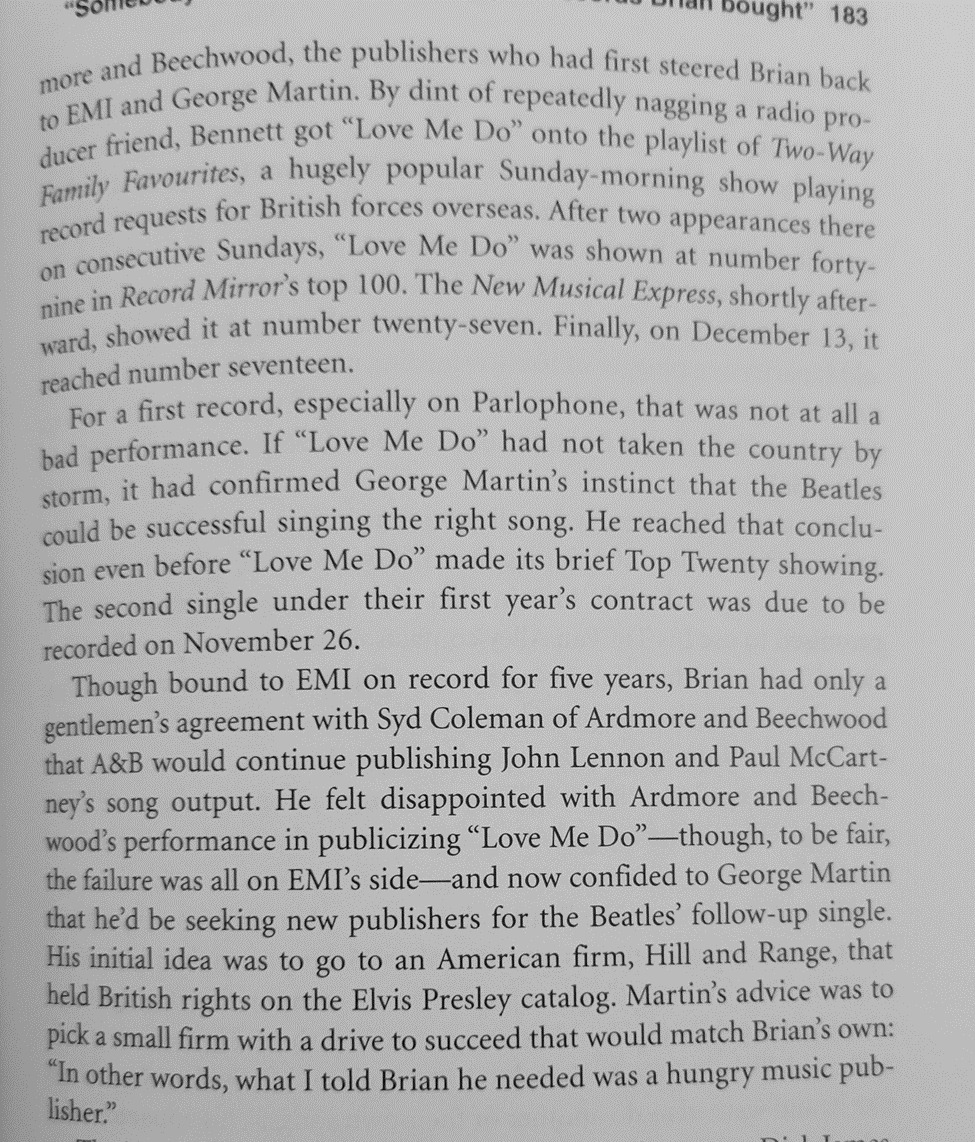
Bennett secures some airtime on Two-Way Family Favourites by “repeatedly nagging a radio producer friend.” This is not the same radio show mentioned in Beatles Book Monthly Issue 13 (above), but it’s in keeping with Bennett’s role as a plugger—and that’s where Bennett’s involvement ends in Shout! (2003). There’s one more tantalizing mention of Brian’s “gentlemen’s agreement” with Colman, which he breaks due to his dissatisfaction with A&B, turning to George Martin for publishing advice.
There you have it: Kim Bennett’s evolving story pre-Tune In. It starts as a bit of extra detail that fits inside the greater framework of the Beatles’ Contract Saga, and, after thirty years, morphs into something that contradicts Bennett’s earlier version and the many other accounts of the same events. Things will get even stickier once we get to Tune In. But first…
Section 4: Why Does It Matter?
I can think of three explanations for why Lewisohn pitched Bennett as an unheard witness when he had, in fact, gone on the record before, and none of these explanations helps the credibility of the story.
Explanation 1: Neither Lewisohn nor Bennett knew about Bennett’s previous statements on the matter. This would be extremely damning for Bennett’s reliability, as it would mean he had forgotten both his 1960s statement to Beatles Book Monthly (plausible) as well as the interview that led to the information included in Shout! (concerning). This scenario also requires Lewisohn to be unaware of the above Bennett appearances, which doesn’t reflect well on his abilities as a researcher. If you find someone who you think has never been on record, you might want to at least look him up in the glossary of books by major Beatle authors.
Explanation 2: Bennett knew; Lewisohn didn’t. Perhaps Kim Bennett either neglected to inform Lewisohn of his past interviews, or outright lied to him on the matter. Lewisohn says that Bennett is “known for a dogged persistency” (Lewisohn 2013, p.571), has said that Bennett “just picks something up and he will not let it go,” (Let It Roll 2020, ~25:50), that he is “very insistent about things” and by the time Lewisohn interviewed him, “was a very frustrated man because no one had ever paid him the attention that he felt was his due.” (Nothing Is Real S7Ep7) Could this tenacity and feeling of entitlement to a part of the Beatles’ legacy have led Bennett to present himself as a bigger scoop than he really was? Might he have sold Lewisohn a tale of exclusivity and, perhaps, a version of the Contract Story more salacious and headline-grabbing than the truth?
Again, this explanation also hinges on the idea that Lewisohn was in the dark about Bennett’s prior interview(s), which is a huge oversight, but not as damning as explanation 3.
Explanation 3: Lewisohn knew and lied. Whether Bennett told Lewisohn outright that he had been interviewed in the past or if Lewisohn came upon that information in his research, Lewisohn chose to portray his interview with Bennett as exclusive. Perhaps this was purely to make his “scoop” seem juicier. Perhaps he was reluctant to give Philip Norman credit for finding Bennett first – there seems to be no love lost between Lewisohn and his former employer. Or perhaps Lewisohn knew that Bennett’s prior accounts made the story told in Tune In less credible. The early anecdote related in BBM already conflicted with the revised version in Shout! – if Bennett’s account, as related in Tune In, presented further inconsistencies, it would undermine Lewisohn’s major finding.
I’ll close with a segment from one of the better Lewisohn interviews I’ve heard. It’s from Ken Michaels’ radio show ‘Every Little Thing’, conducted in ~2013, and it’s one of the rare instances where an interviewer gives Lewisohn any pushback or asks follow-up questions regarding some of his more explosive claims. It’s an uncomfortable listen – Ken Michaels even appeared in the comments of this YouTube channel to counter claims that he has beef with Lewisohn– but satisfying to hear some meaningful questions when so many people are content to simply deify Lewisohn. Here’s the relevant exchange:
KM: Aren’t there also problems with certain people that you’ve interviewed that have played some part in Beatle history that want to really elevate their status?
ML: Oh yeah, oh yeah, and it’s up to authors to ensure that they don’t get what they want. And there are unfortunately too many authors who just very happily take the stuff they’re given without challenging it. You’ve got to challenge all these things. And unless something completely fits into the framework of the story, you can’t use it.
Next time, on Days of Our Lies: the Classic Version of the Contract Story, and why Mark Lewisohn is so intent on debunking it. After that, we’ll finally look at the Contract Story as portrayed in Tune In.
Sources:
Cockcroft S, Carty J. 2023 Feb 14 [conducted 2023 Jan]. Nothing Is Real – Season 7 Episode 7 – Mark Lewisohn Returns [podcast, season 7, episode 7]. Nothing Is Real. 1:17:15. Available from: https://open.spotify.com/episode/5mtbNIreAY0Car6VASuZGV?si=b1e322e001a347e3
Coleman R. 1989. The Man Who Made the Beatles: An Intimate Biography of Brian Epstein. New York (NY): McGraw-Hill Publishing Company. 400p. Accessed online 2024 Mar 19. Available from: https://archive.org/details/manwhomadebeatle00cole/mode/2up
Kelly D. 2014 Jul 30. Setting the Record Straight: Interview with Beatles biographer Mark Lewisohn. Critics at Large. Accessed 2024 Mar 4. Available online: https://www.criticsatlarge.ca/2014/07/setting-record-straight-interview-with.html
Kozinn A. 2013 Dec 27. Tune In, and Turn On the Reading Light. ArtsBeat: New York Times Blog [accessed 2024 Feb 6]. Available from: https://archive.nytimes.com/artsbeat.blogs.nytimes.com/2013/12/27/tune-in-and-turn-on-the-reading-light/?_r=0
Lewisohn M. 1992. The Complete Beatles Chronicle. New York(NY): Barnes & Noble Books. 365p. Accessed online 2024 Mar 14. Available from: https://archive.org/details/completebeatlesc0000lewi/mode/2up
Lewisohn M. 2013. 1st U.S. Edition. The Beatles: All These Years Vol. 1: Tune In. New York (NY): Crown Archetype. 932p.
Lichtman I [editor]. 1965 Apr 24. Great Britain. Cash Box XXVI(40); International Section p.45. Accessed online 2024 Mar 18. Available from: https://archive.org/details/cashbox26unse_31/page/44/mode/2up
Lichtman I [editor]. 1965 Jun 5. Great Britain. Cash Box Vol.XXVI(46); International Section p.55. Accessed online 2024 Mar 13. Available from: https://archive.org/details/cashbox26unse_37/mode/2up
Lichtman I [editor]. 1965 Jul 24. Great Britain. Cash Box Vol. XXVI(53); International Section p.53. Accessed online 2024 Mar 13. Available from: https://archive.org/details/cashbox27unse/mode/2up
Lichtman I [editor]. 1967 Jul 22. Overlooking South Africa. Cash Box Vol.XXVIII(52); International Section p.65. Accessed online 2024 Mar 13. Available from: https://archive.org/details/cashbox28unse_50/mode/2up
Martin G, Hornsby J. 1979. All You Need is Ears. New York (NY): St. Martin’s Griffin. 293p.
Martland P. 1997. Since Records Began: EMI: The first 100 years. London: B.T. Batsford Ltd. 359p. Accessed online 2024 Mar 17. Available from: https://archive.org/details/sincerecordsbega0000mart/mode/2up
Michaels K. 2013. Mark Lewisohn interview [radio broadcast episode]. The Beatles – Every Little Thing. Originally aired on XM Radio. 1:53:18. Available from: https://www.youtube.com/watch?v=CjAUtngSoKc
Parnes S [editor]. 1958 Jul 26. Ardmore & Beechwood Open London Office. Cash Box Vol. XIX(45); p.34. Accessed online 2024 Mar 18. Available from: https://archive.org/details/cashbox19unse_43/page/34/mode/2up
Southall B, Perry R. 2006. Northern Songs: The True Story of The Beatles Song Publishing Empire. London: Omnibus Press. 218p. Accessed online 2024 Mar 13. Available from: https://archive.org/details/northernsongstru0000sout/mode/2up
*Wicks D. 1998. Updated 2012. The Ballad Years: From the Bombs to the Beatles: a Directory and Discography of British Popular Music-makers from 1945-1960. Accessed online 2024 Mar. Available from: https://archive.org/details/theballadyears/Book%20Contents/
Wilcox N. 2020 Apr 27. How The Beatles Got Signed [podcast, season 7]. Let It Roll. 57:21. Available from: https://dcs.megaphone.fm/PAN2878353172.mp3?key=5204cb23c38410bae94e208461239e2d&request_event_id=e800ecea-9c5e-40f2-90e3-dad820306501
Images from The Ballad Years and Cash Box 1967 Jul 22
*The Ballad Years by Don Wicks was originally published circa 1998 (by a company called In Tune International, of all things!) There is some great contextual info included at the Internet Archive link; to condense it here, after the original print run of the book, Don Wick continued to update the book, primarily to reflect the death of artists. He distributed these via Microsoft Word Document, and the 2012 version of these documents was uploaded to the Internet Archive. I believe that is the reason for “The Barry Sisters” being plastered across Kim Bennett’s face – the pages including artists’ pictures have very wonky formatting.

2 Comments Add yours